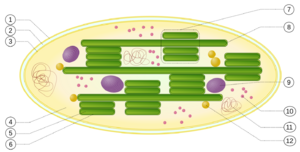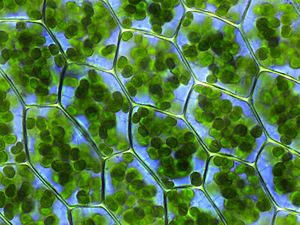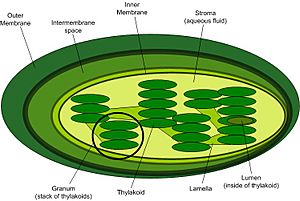Chloroplast facts for kids

1. outer membrane
2. intermembrane space
3. inner membrane (1+2+3: envelope)
4. stroma (fluid inside)
5. thylakoid lumen (inside of thylakoid)
6. thylakoid membrane
7. grana (stacks of thylakoids)
8. thylakoid (flat sac)
9. starch (stored sugar)
10. ribosome
11. plastidial DNA
12. plastoglobule (fat drop)
Chloroplasts are tiny parts, called organelles, found inside the cells of plants and algae. Their main job is to capture light energy. They use this energy to make sugar in a process called photosynthesis. This sugar is like food for the plant and can be stored as starch.
Chloroplasts contain a special molecule called chlorophyll. This is the green pigment that absorbs sunlight for photosynthesis. Besides chlorophyll, chloroplasts also use carbon dioxide (CO2) from the air and water (H2O). They turn these into sugar and release oxygen (O2) back into the air. Chlorophyll is also what gives green plants their green color. Chloroplasts also have yellow and orange pigments. These help them capture even more light for photosynthesis.
What are Chloroplasts Made Of?
Each chloroplast is surrounded by two protective layers called membranes. Inside, there are stacks of flat, disk-shaped sacs called thylakoids. These thylakoids hold the pigments that absorb light, like chlorophyll and carotenoids. They also contain special proteins that help these pigments work.
Just like mitochondria, which are other parts of a cell, chloroplasts have their own DNA. They also have their own ribosomes. This means they can make some of their own proteins.
How Chloroplasts Evolved
Scientists believe that chloroplasts started out as tiny, free-living bacteria. These bacteria are called cyanobacteria. Over a very long time, a larger cell "swallowed" one of these cyanobacteria. Instead of digesting it, the larger cell and the cyanobacterium began to live together. This is called endosymbiosis. This idea was first suggested in the early 1900s.
Most chloroplasts today are thought to have come from this single event. Mitochondria also have a similar story. However, chloroplasts are only found in plants and some protists. In green plants, chloroplasts have two membranes. These are thought to be the original outer and inner membranes of the ancient cyanobacterium.
Chloroplasts have their own small set of DNA. This DNA is much smaller than the DNA of free-living cyanobacteria. But the DNA that remains in chloroplasts is very similar to cyanobacterial DNA. Many genes that were once in the cyanobacterium's DNA are now found in the plant cell's main DNA.
In some types of algae, chloroplasts seem to have evolved in a different way. A eukaryotic cell might have engulfed another eukaryotic cell that already had chloroplasts. This can lead to chloroplasts with three or even four membrane layers.
Images for kids
-
Chloroplasts visible in the cells of Bryum capillare, a type of moss
-
A Transmission electron microscope image of a chloroplast. You can clearly see the stacks of thylakoids (grana) and their connections.
-
Instead of an intermembrane space, glaucophyte algae have a peptidoglycan wall between their inner and outer chloroplast membranes.
See also
 In Spanish: Cloroplasto para niños
In Spanish: Cloroplasto para niños







